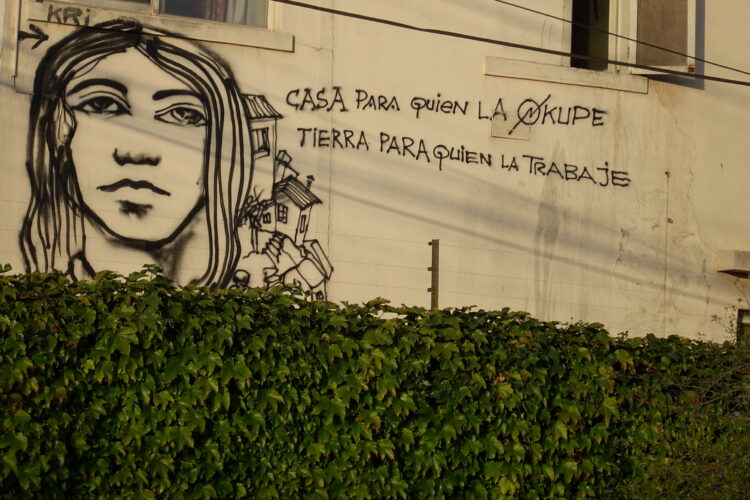¡Feliz día de las y los trabajadores! Es el slogan de estos días, pero ¿es realmente un día feliz para quienes trabajan día a día? Cuando ponemos en contexto esta celebración conmemorativa se hace evidente que no hay mucho que celebrar. Recordemos que esta fecha conocida como el Día Internacional de las y los Trabajadores es un evento del movimiento obrero mundial, un homenaje a los mártires de Chicago que fueron ejecutados en EEUU por participar en una huelga que inició el 1 de mayo de 1886 y que buscaba lograr una jornada laboral de 8 horas al día, en vez de las 12 o 16 que solían trabajar. A pesar de que desde 1868 existía una ley que estipulaba una jornada laboral de 8 horas diarias, varias ciudades, como Chicago, importante centro industrial, simplemente no la aplicaban. Así, el primero empieza la paralización, se producen disturbios, las fuerzas represivas de la policía hieren a 6 manifestantes, por lo que se convoca a una nueva manifestación para el 4 de mayo que termina con un saldo de 38 trabajadores muertos y más de 200 heridos. Posteriormente, 38 de los trabajadores convocantes y participantes fueron enjuiciados, siendo 5 condenados a la horca y otros 3 a prisión.
Dadas estas circunstancias, el Congreso Obrero Socialista de la Segunda Internacional, celebrado en 1889 en París acuerda honrar a las y los trabajadores cada 1 de mayo, convirtiéndose en un día festivo en casi todo el mundo, excepto en su lugar de origen, ya que EEUU y Canadá celebran un día del trabajo en septiembre para no coincidir con el carácter socialista de la conmemoración de mayo, que apunta a la lucha por más derechos laborales para la clase trabajadora, entonces, insistimos ¿qué celebramos? Si vemos otra fecha emblemática, como el día de la mujer, nos encontramos con otra serie de manifestaciones por los derechos laborales y sociales de las mujeres trabajadoras que van escalando desde una primera marcha de las obreras textiles en 1857, en la que murieron 120 personas, hasta los incendios de la Cotton Textile Factory, en 1908, con un resultado de 120 trabajadoras muertas y el de la fábrica Triangle Shirtwaist, en 1911, en el que murieron 146, ambos en Nueva York, y que sentaron el precedente para que la segunda Conferencia Internacional de Mujeres Socialistas propusiera la instauración del Día de la Mujer Trabajadora, que luego, en 1971 quedó instaurado por la ONU como el Día Internacional por los Derechos de la Mujer y la Paz Internacional.
En el 2012 el incendio de una fábrica textil en Bangladesh nos trajo a la memoria estos terribles eventos, ya que se revelaron las inhumanas condiciones laborales de las trabajadoras; luego en el 2013, el derrumbe de un edificio que albergaba 5 talleres de confección textil dejó un saldo de 300 muertes y más de mil heridos y reveló a una industria que facturaba 15 millones de euros en exportaciones mientras pagaba salarios mensuales de 28 euros. Pasan los siglos y las condiciones laborales no mejoran realmente y vemos cómo el trabajo queda limitado a su etimología como instrumento de tortura (el Tripallium). Lo que nos lleva a profundizar nuestro cuestionamiento, ¿cuál es el sentido del trabajo?, ¿tenemos motivos de celebración si en muchas partes del mundo aún hay esclavitud? Desde los “padres fundadores” hasta el libertador de América tenemos un pasado esclavista que es el que ha conformado las grandes fortunas de Europa y América. Una de las máximas fortunas del planeta se consolidó con el saqueo de piedras preciosas en África, algo similar sucede con el gigante transnacional, Amazon, que en el 2021 tuvo una ganancia de 200 millones de dólares en un día en las cotizaciones de Wall Street, con un patrón que cobra un sueldo de 1.68 millones de dólares, mientras sus empleados ganan un promedio de 28 mil, quienes recién este año forman un sindicato. Entonces pareciera que nuestro trabajo es sólo para el enriquecimiento del dueño de la empresa y esa no es una razón para celebrar.
No hay mal que dure 100 años, dicen, sin embargo, la explotación humana lleva milenios, aunque ahora, gracias a la pandemia, eso podría cambiar. La Gran Renuncia, le dicen al fenómeno que agobia al empresariado en EEUU después de que más de 4,5 millones de personas renunciaran a sus trabajos a fines del año pasado. Las razones son evidentes, después del encierro las personas descubrieron que tenían una vida más allá de su “tortura”, descubrieron que tenían hijos, hijas, padre, madre, hermandades y vecindades, descubrieron que gran parte de su sueldo vuelve a invertirse en el trabajo, en los viajes a la oficina o la construcción, en las personas e instituciones que deben contratar para cubrir su ausencia en el hogar, limpiadores, cuidadores, niñeras; descubrieron que se podía trabajar desde la casa y que eso les permitía disfrutar de su vida. Este fenómeno se ha extendido en diversa medida por el mundo, lo que sumado a los conflictos bélicos y el caos climático, proponen un momento único de transformaciones en nuestro paradigma social. Tierra y libertad, exigían Emiliano Zapata y Flores Magón durante la fallida revolución mexicana que inauguraba el pasado siglo XX, Tierra y libertad parece ser la solución hoy día para nuestra supervivencia y felicidad.
Happy workers’ day! It is the slogan of these days, but is it really a happy day for those who work every day? When we put this commemorative celebration in context, it becomes clear that there is not much to celebrate. Let us remember that this date known as International Workers’ Day is an event of the world labor movement, a tribute to the Chicago martyrs who were executed in the US for participating in a strike that began on May 1, 1886 and that sought to achieve a working day of 8 hours a day, instead of the 12 or 16 that they used to work. Despite the fact that since 1868 there was a law that stipulated an 8-hour workday, several cities, such as Chicago, an important industrial center, simply did not apply it. Thus, the first strike begins, riots break out, the repressive police forces injure 6 protesters, so a new demonstration is called for May 4, which ends with a balance of 38 dead workers and more than 200 wounded. Subsequently, 38 of the convening and participating workers were prosecuted, with 5 sentenced to hanging and another 3 to prison.
Given these circumstances, the Socialist Workers’ Congress of the Second International, held in 1889 in Paris, agreed to honor the workers every May 1, becoming a holiday in almost the entire world, except in their place of origin, since The US and Canada celebrate a labor day in September so as not to coincide with the socialist character of the commemoration in May, which points to the struggle for more labor rights for the working class, so, we insist, what do we celebrate? If we look at another emblematic date, such as Women’s Day, we find another series of demonstrations for the labor and social rights of working women that have escalated since the first march of textile workers in 1857, in which 120 people died, until the fires of the Cotton Textile Factory, in 1908, with a result of 120 dead workers and the Triangle Shirtwaist factory, in 1911, in which 146 died, both in New York, and which set the precedent for the Second International Conference of Socialist Women proposed the establishment of the Working Women’s Day, which later, in 1971, was established by the UN as the International Day for Women’s Rights and International Peace.
In 2012, the burning of a textile factory in Bangladesh brought to mind these terrible events, since the inhuman working conditions of the personnel were revealed; then in 2013, the collapse of a building that housed 5 textile manufacturing workshops left a balance of 300 deaths and more than a thousand injured and revealed an industry that invoiced 15 million euros in exports while paying monthly salaries of 28 euros. Centuries go by and working conditions do not really improve and we see how work is limited to its etymology as an instrument of torture (the Tripallium).* Which leads us to deepen our questioning, what is the meaning of work? Do we have reason to celebrate if in many parts of the world there is still slavery? From the «founding fathers» to the liberator of America, we have a slave past that has shaped the great fortunes of Europe and America. One of the greatest fortunes on the planet was consolidated with the looting of precious stones in Africa, something similar happens with the transnational giant, Amazon, which in 2021 had a profit of 200 million dollars in one day on Wall Street prices, with a boss who earns a salary of 1.68 million dollars, while his employees earn an average of 28 thousand, who just this year formed a union. So it seems that our work is only for the enrichment of the owner of the company and that is not a reason to celebrate.
There is no evil that lasts 100 years, they say, however, human exploitation takes millennia, although now, thanks to the pandemic, that could change. The Great Resignation, they say to the phenomenon that overwhelms the business community in the US after more than 4.5 million people quit their jobs at the end of last year. The reasons are obvious, after the confinement people discovered that they had a life beyond their «torture», they discovered that they had sons, daughters, father, mother, brotherhoods and neighborhoods, they discovered that a large part of their salary is reinvested in the work, on trips to the office or construction, in the people and institutions that must be hired to cover their absence at home, cleaners, caregivers, nannies; they discovered that they could work from home and that allowed them to enjoy their lives. This phenomenon has spread to varying degrees throughout the world, which, added to armed conflicts and climatic chaos, propose a unique moment of transformations in our social paradigm. Land and Liberty, Tierra y libertad, demanded Emiliano Zapata and Flores Magón during the failed Mexican revolution that inaugurated the last century XX, Land and Liberty seems to be the solution today for our survival and happiness.
*The word “trabajo” (work) comes from the verb “trabajar” (to work), and this verb comes from the Latin verb “tripaliare“. Tripaliare derived from “tripalium” which meant “three sticks”. A tripalium was a yoke made with three sticks which were tied to slaves to beat them as a way of punishment.








